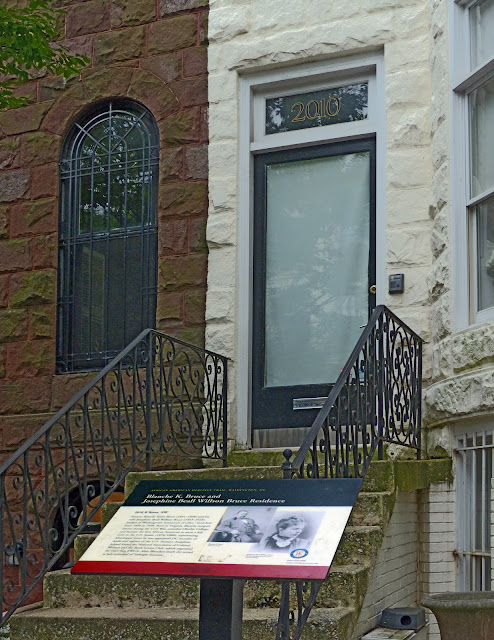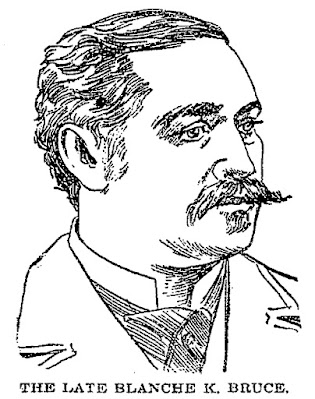This photo of Hon. Blanche Kelso Bruce of Mississippi belongs to the Brady Handy collection at the Library of Congress. The library describes Bruce as an “African American legislator”.
Booker T. Washington described Blanche K. Bruce this way in his 1900 book The Future of the American Negro.
I might name several characters who were brought before the world by reason of the reconstruction period. I give one as an example of others: Hon. Blanche K. Bruce, who had been a slave, but who held many honourable positions in the State of Mississippi, including an election to the United States Senate, where he served a full term; later he was twice appointed Register of the United States Treasury. In all these positions Mr. Bruce gave the greatest satisfaction, and not a single whisper of dishonesty or incompetency has ever been heard against him. During the period of his public life he was brought into active and daily contact with Northern and Southern white people, all of whom speak of him in the highest measure of respect and confidence.Blanche Bruce was one of two reconstruction-era African American U.S. Senators. The first was Hiram Revels who was sent in 1870 to fill one of the vacancies in the Senate left open since 1861. His term expired in March 1871. Bruce was elected by the Mississippi legislature in 1874 and served from 1875 to 1881. He is often described as the First African American to serve a complete term in the Senate. His 2001 senate portrait by Simmie Knox was commissioned in 1999.
Blanche Bruce was born enslaved in Farmville Virginia. This historical marker is on Rt. 360 in Green Bay Virginia. (photo by Bernard Fisher.)
Bruce somehow acquired both education and aristocratic manners. Many sources point out that he was assigned to his master's son as companion and was educated by the son's tutor. It is alleged that Blanche Bruce may have been the natural son of Pettus Perkinson, his master, and he may have therefore received special favor from Perkinson.M 35Blanche Kelso BruceBlanche Kelso Bruce, African American political leader, was born into slavery south of here on 1 Mar. 1841. He grew up in Virginia, Mississippi, and Missouri before escaping slavery during the Civil War. In 1869 Bruce moved back to Mississippi and became active in local and state politics. In Feb. 1874, the Mississippi legislature elected him to the U.S. Senate. Bruce was the first black to serve a full term in the Senate (1875-1881). After completing his term in office, he held several political positions in Washington, D.C. He died on 17 Mar. 1898 in Washington, D.C., and was interred there in Woodlawn Cemetery.
Bruce’s first name was originally “Branch,” but he changed it to “Blanche” as a teenager. For unexplained reasons, he later adopted the middle name “Kelso.”The St. Paul Globe, in 1887, tells the story differently:
It was forty-six years ago the first of March, 1841, when he was born and received the singular name which he has clung to although frequently importuned to change it to something that had more of the ring of masculinity about it. An old friend of his mother's was visiting the family prior to his appearance in this mundane sphere, and as her name was Blanche, it was decided that the baby should he called after her. Contrary to expectation, however, it was a boy child, but Mrs. Bruce persisted in her determination and named it Blanche.
“I have been tempted frequently to drop the final c,” said the lecturer in discussing the matter with a representative of the Globe, “but eventually I came to the conclusion that I had made my reputation as Blanche K. Bruce and hence would stick to the name until I died.”
This woodcut of Ex Sen. Bruce accompanied the Globe story.
This photo of Bruce appeared in Booker T. Washington's My Larger Education, 1911.
Blanche K. Bruceof MississippiWho was born a slave, but was thefirst Negro to become a member ofthe United States Senate
Senator Bruce lived in this second-empire house at 909 M Street between 1875 and 1881 during his senatorial term. (HABS photo)

In 1897, Blanche Bruce was again appointed Register of the Treasury by McKinley. He died of complications of diabetes on March 17, 1898. This woodcut appeared in his obituary in the Louisville Courier-Journal, the next day.



















No comments:
Post a Comment